
Jen Agg looks out the window at Toronto's Bar Vendetta, which she owns. It's Nov. 30, a week since a new lockdown was introduced in Toronto to stop the spread of COVID-19: Among other things, the measures closed dine-in restaurant service.Jenna Marie Wakani/The Globe and Mail
Jen Agg is a Toronto restaurant owner and the author of I Hear She’s A Real Bitch.
One evening in late August, my husband, Roland, and I walked from our home to Bar Vendetta, a restaurant I own, to have dinner for the first time since mid-March. That month, when Toronto first plunged into lockdown, I shut down all five of my restaurants.
It was a notable walk, as they have all come to be, because Roland has been in stroke recovery for the past seven months and, back in August, walking even the short distance to the restaurant was a huge achievement.
We sat down at the table, ordered a nice, light red, and slipped our masks off – truly basking in the joy of being around people, any people. I’ve found it pretty easy to stay in touch with close friends, but it’s everyone else – coffee shop pals, strangers on the street, casual acquaintances who I’d run into unexpectedly at a noisy bar – who I missed the most. When our puntarelle salad dropped, I yelled across the patio to friends sitting at another table that they had to order it, too. For the next 90 short minutes, it felt like things were … if not normal again, then pretty okay.
Of course, we understood that things were not at all okay, but that’s part of the wonderful experience of dining out: You get to leave the stresses of your life behind, whatever they may be, and suspend yourself in a world where people bring you delicious things to eat and drink. Even though it’s seemingly a simple money-for-services transaction – you are paying to not have to mix your own highball, cure your own salumi, roll out your own fresh pasta, pour your own wine or clear your own plates – dining in a restaurant is so much more than that. It’s the feeling of being cared for, cocooned from the world by the confines of your table. It’s the curation of the music and the design of the room. It’s the flattering lighting that makes everyone a bit more attractive. It’s the sense of harmony – that everything and everyone is working toward a common goal.
Restaurants are magic, and there is no solitude I ache for more than the solitude of being alone in a crowded one again.
Instead of standing at the front of the house, greeting customers new and old, I have spent much of the pandemic being a caregiver. This suits me. Many of the qualities that make me a good boss have helped me with Roland’s recovery: attention to detail, cheerleading, pushing someone beyond what they believe themselves capable of.
I try not to think about the before time, as the memory of my husband walking toward me – a very cool stride – is sometimes unbearable as he learns to walk again. And even if this seems like a callous analogy, I feel similarly about my restaurants. The memory of a bustling dining room – the music just shy of too loud, the lights just sparkling enough to twinkle everyone’s eyes – is almost physically painful. For me, my restaurants are where I draw much of my energy, stolen from people I have the gall to charge for the privileges I gain.
As we head into the 10th month of this strange, terrible time, I often find myself considering my purpose, now that my job – my identity, some might say – is a shadow of its former self. What am I if not a restaurant owner? What will happen if the vaccines aren’t as effective as believed, and we must endure more lockdowns? What happens if restaurants as we knew them are a permanent casualty of the pandemic? What will we lose?
On that warm evening in August, sitting with my husband and laughing with my staff, the answer was all too clear.
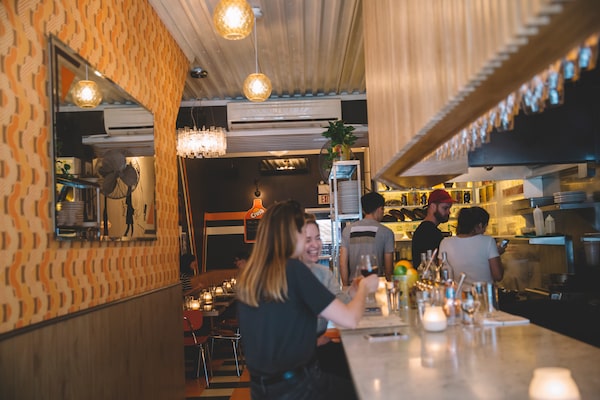

Bar Vendetta, then and now: At top, Patrons sit at the bar in September of 2019, and at bottom, staff prepare meals for takeout and delivery this past November. This space was once The Black Hoof, a charcuterie restaurant that put Jen Agg on Toronto's culinary map. She closed the Hoof in 2018, then reopened the space as Bar Vendetta last year.Photos: Jenna Marie Wakani/The Globe and Mail
I started waitressing when I was 17. It’s the perfect job for a controlling multitasker who loves pretending she can read people with a cult leader’s ease. As I rose through the ranks, eventually getting a job bartending at a busy cocktail bar on Toronto’s College Street, back when College Street was actually cool, I realized that the people employing me weren’t necessarily good at their jobs. So, 22 years old and hubris in full bloom, I went off to build my own cocktail bar with my (now) ex-husband. Over the subsequent decade, I got divorced, met Roland, closed the bar and spent a couple of years playing housewife, subconsciously plotting my next move. My next move turned out to be The Black Hoof.
Excluding a few bad decisions and misadventures, to say it went well is an understatement. Eventually, after many years of working every service, I was able to step back from the Hoof and focus more on the bigger picture, which was the acquisition of spaces in which I could spend a year – ideally less but sometimes longer – constructing a new restaurant based on flights-of-fancy ideas that sloshed around in my head and eventually hardened into something specific from which I could not deviate: the exact vintage wallpaper; a weird knick-knack plucked from the dusty basement of a second-hand store; the perfect bathroom mirror. Over the span of 12 years, I opened eight different restaurants, five of which I continue to operate today. Sort of.
When the pandemic came hurtling at us like a burning oil-tanker back in March (except the fire was in the engine room, invisible under the waterline), I had to make many extremely quick decisions from thousands of miles away. Roland and I were in Los Angeles, and as things went from bad to worse, we scrambled to book tickets home weeks earlier than planned.
I spent days on the phone with my partners and restaurant managers, trying to navigate a situation that was changing daily. At first the messaging was: space out your tables, wash your hands all the time and clean everything constantly, which we did vigorously, but within a few days this felt inadequate, partly performative and even morally questionable. We didn’t know much about this mystery disease back then, but what was becoming clear was that staying home, not eating out, was a good idea. Finally, I decided that it was incredibly hypocritical for me to tweet that everyone should stay home while I kept my restaurants open. We closed down all five restaurants a day before the lockdown was announced.
Now what?
I had a feeling, unlike the people saying things would be back to normal soon, that we were in for a long haul. (I tweeted a prediction of eight months, which in March felt a lifetime away; wow, do I wish I’d been right.) My main concern was for the 75 staff members working at the various restaurants. They were all laid off quickly, so they could apply for employment insurance (and, later, the Canada Emergency Response Benefit, or CERB). The days that followed were a mad scramble to shut the restaurants down properly. There were refrigerators full of food to deal with, garbage collection to cancel, kitchens to clean and myriad other details to figure out. We gave the food to our staff, solving one problem, but otherwise we were flying blind with no idea how long the closings would last, and no way to reassure anyone on staff about any kind of economic stability. I was doing my best to deal with all the chaos remotely, but felt incredibly guilty that I wasn’t there, scrubbing down the restaurants alongside my colleagues.

Ms. Agg's restaurant in Kensington Market, Grey Gardens, closed when the pandemic struck in March, as did many of the businesses in the neighbourhood.Fred Lum/The Globe and Mail
We arrived home on March 16, and had to isolate for 14 days. After which, we took stay-at-home orders seriously, as Roland is in his 60s and thus at higher risk when it comes to COVID-19. In the end, it wasn’t just the coronavirus that we had to worry about – all the stress of the previous weeks had caused Roland’s blood pressure to skyrocket, putting him at real risk of a stroke. Unfortunately, it happened in late April. And time stopped, for real.
May and June were two of the worst months of my life. I wasn’t allowed to visit Roland, who after being released from the hospital was transferred to a rehabilitation facility, and even though we FaceTimed all day, he was desperately lonely. I was surrounded by friends, who were rallying around with support and cooking, but without Roland, I was desperately lonely, too. Along with feeling completely unmoored by Roland’s absence, I was experiencing PTSD – replaying his stroke over and over and over in my head, imagining what might have happened if I’d left the house, as I’d planned to do that day. My thoughts were unbearably dark. Eventually, I kicked up such a fuss they let me see him a couple of times near the end of his stay. A few days after he was released they adjusted the rules so that essential caregivers were permitted to visit – too late for Roland and me, who had suffered through seven miserable weeks apart.
As soon as he came home in late June, we quickly developed a rehab routine. The pandemic was still permeating everything around us, but our personal struggles blocked it out. In a strange way, I guess the one good thing about your husband having a stroke during a pandemic is that it really distracts you from the fact your entire livelihood hangs in the balance. I tried not to think about how close I was to potentially losing everything.
The federal government (eventually) introduced some real protections to help small-business owners. For instance, CERB was a lifeline for my staff, about whom I had been panicked until it was announced. (It also highlighted how bad things were in the United States, where restaurant workers were completely ignored.)
The Canada Emergency Commercial Rent Assistance (CECRA) program for rent relief, announced on April 24, was set up so tenants would pay 25 per cent of their rent, with the landlord receiving another 50 per cent through a government subsidy. To me, landlords being asked to make do with 25 per cent less in rent didn’t feel like such a big ask when bars and restaurants were taking a 75-per-cent hit or worse. Landlords cannot be the only ones immune from market forces and must share a bit of the burden.
But nearly two-thirds of the entrepreneurs that the Canadian Federation of Independent Business estimated would be eligible for CECRA didn’t see a dime from it – in large part because landlords, including one of mine, refused. (To his credit, he offered a 50-per-cent rent reduction for three months, which helped a bit.) Yet even with that help, restaurants were already falling behind. Running a restaurant costs more than just rent – it’s payroll, it’s utilities, it’s quarterly HST payments, it’s 30 days of supplier bills and no revenue to cover any of them. Anyone out there tut-tutting and regurgitating business school mantras like “you need at least six months of operating capital in the bank at all times” hasn’t come off a long Canadian winter as a restaurant owner. March is when things start looking up. May is when the city cracks open with life. Instead, this year the winter continued into spring, and then summer.
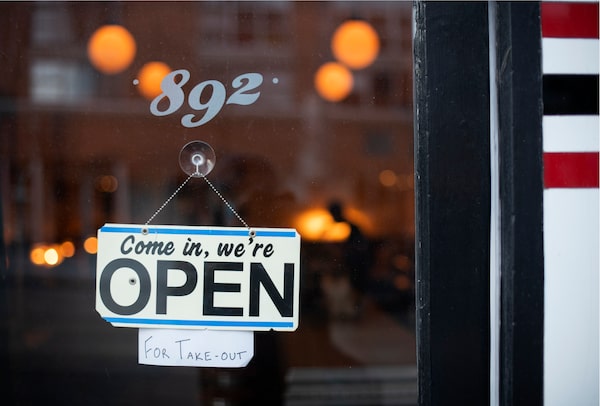
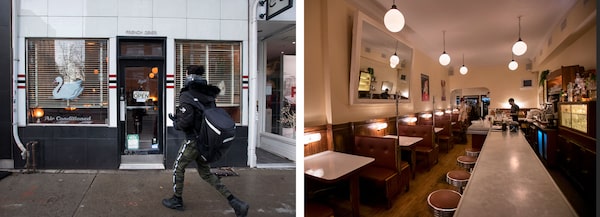
At the Agg-owned Le Swan restaurant on Queen Street West, food is currently for takeout and delivery only, the latest of many business models it's cycled through as the pandemic continues. At bottom left, a courier arrives outside; at bottom right, general manager Allie Higgins prepares meals.Photos: Fred Lum/The Globe and Mail
Like other restaurants, faced with little choice, we pivoted, hard, wherever we could.
It honestly sucked. Restaurants are restaurants – they are not grocery stores, UberEats pit stops or wine shops. At Le Swan we held a BBQ every weekend, which barely kept the lights on. We turned Bar Vendetta into a wine-and-pasta-kit shop and, in June, got the patio up and running (which actually helped – restaurants with patios were at a huge advantage). We did weekend pick-up at Rhum Corner. Our choices at Cocktail Bar were made much more difficult by Ontario’s draconian liquor laws – for example, you can’t sell premixed cocktails to-go, which means asking people to spend $40 on sealed mickey cocktail kits. If restaurants are screwed, bars are really screwed. It all felt like wet Band-Aids. Still, we had to adapt to the situation to try to survive. But all those other things, those things that are not restaurants, aren’t what we do. Selling people food and wine is hardly the same thing as selling people an experience.
But we had no choice, so we kept throwing things at the wall to see what would stick. With any new concept (pasta kits, wine shop, BBQ) people would rally at the beginning, which was lovely, but none was sustainable long-term. We also had staff begging to work as the possible end of CERB approached, with no assurance what financial support, if anything, would be available afterward. So much of the government’s mismanagement of the pandemic has been around the messaging – not disseminating information quickly enough, sowing panic and confusion.
Toronto entered “Stage 3” on July 31, and we were permitted to open for indoor dining. We eventually felt we had to open up the Swan dining room to make rent, as we had fallen behind and felt at real risk of eviction. I didn’t want to promote indoor dining, and we waffled over it for weeks, weighing the pros (we might not lose our beautiful restaurant … maybe) and cons (was it safe for our staff and guests, even with tables distanced, and fewer than 15 people inside at any one time?). In the end, we decided to try it, and went for about a month without incident before a new ban on indoor dining arrived in Toronto on Oct. 10. Then we pivoted, again, to food delivery apps, which we’d never wanted to do. Sadly, we felt far removed from the privilege of choice. (So, just to be clear, at Le Swan alone we’ve gone from take-out and wine shop, then a BBQ, then reduced capacity indoor dining, to relying on a food delivery app, which we will continue to do until this is all over.) Stress, time, money and energy went into each of these pivots.
Now winter is coming, and for restaurants it’s going to get worse, a lot worse, until a vaccine arrives and things get better – hopefully. Restaurants are going to close in droves before we get there. And I find that beyond sad. The restaurant business is an extremely challenging industry. People have poured their life savings in pursuit of their dreams, and all those dreams killed by COVID-19 is added cruelty to the death and destruction it’s brought to the rest of society.
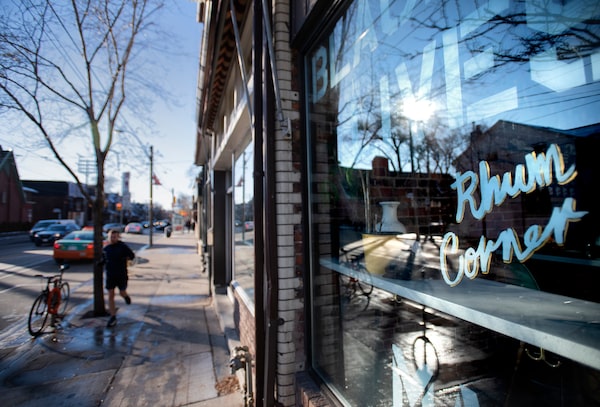
Bar Vendetta's neighbour, Rhum Corner, is open for pickup three days a week.Fred Lum/The Globe and Mail
The cracks in so many of our systems were deepened and widened by the daily pressures of a global pandemic, and this goes tenfold for my industry. As much as I love restaurants, I have made my side hustle writing about what actually goes on in them.
Part of the bargain of working in an industry that is historically extremely exploitative is that it’s, at the very least, fun. But with minimal staff and few patrons to actually interact with, things became perfunctory and way less fun. Additionally, with stay-at-home orders in place, people had more time to think about the systemic problems in the industry, and without daily contact with their bosses, power vastly shifted – what even is power in this business if you don’t have a full restaurant every night to reinforce it?
Discontent began to simmer. I watched it play out online, where the corporate hashtag #savehospitality became #changehospitality, as rightfully unhappy former restaurant workers seized the message. The truth, I realized, was that not every restaurant deserved to be saved.
What drove it home was when chef Rob Gentile of Buca fame posted a “goodbye” picture on Instagram, when he announced he was leaving his company in mid-November, in which his staff was literally carrying him on their shoulders. The King Street Restaurant Group, parent company to Buca, La Banane, Jacobs & Co. and many other Toronto restaurants, had just secured creditor protection and was in debt to the tune of $46-million dollars, much of it owed, according to the debt sheet, to small, family owned vendors and agencies. This was old debt, not just accrued during the pandemic. The same month, a former employee of Jacobs & Co. went to the Ontario Human Rights Tribunal with a sexual harassment allegation.
Seeing that Instagram post, I did what I have always done and took to social media to shine a light on the problems with this industry – an industry that I love. This time, I got much more support than I’m used to getting when punching up at powerful and beloved restaurant people.
But as much as I’d like to envision a new industry model rising out of the “burn it all down” ashes of the old one, until the dining public agrees to pay considerably more for dining out, nothing much will change. Which is why it’s so important to draw attention to bad actors, even as they operate within systemic problems that are so much bigger. They don’t like it much. They always feel so attacked. But it isn’t an attack, it’s a spotlight, and one they stepped into. And it’s one of the few tools we have to underscore how unequal, problematic and historically terrible so many restaurants are. Things need to change.
A dinosaur-like extinction is what’s on the way. Winter is the meteor. When this all started, I imagined 60 per cent of restaurants wouldn’t make it. That is starting to feel like wishful thinking. The payroll protection subsidy is amazing, and we would have closed without it. The new Canada Emergency Rent Subsidy is great, as it doesn’t demand the landlord’s consent and goes directly to tenants, but so far we don’t know if it will carry on into the New Year, and realistically, we need it to.
My asks are small and would-be game-changers: We should have wholesale alcohol pricing like almost everywhere else in the world – restaurants pay retail, which is honestly insulting. We need the government to intervene with delivery apps charging restaurants exorbitant prices of up to 30 per cent of the total sale. Fifteen per cent is reasonable, 30 per cent is not. We need the rent subsidy until this is truly over and we can operate at full capacity again. And there should be no HST penalties, no late filing fees, no interest charged – the absolute gall to charge interest on late payments at a time like this.
And as far as the dining public: People need to support the restaurants they want to see survive (I order from a big handful of places twice a month minimally) and make the effort to pick up directly, because food delivery apps take a huge cut (UberEats, which we use, charges up to 30 per cent), which makes it even harder to keep afloat. Tip as much as you can – servers and cooks are working hard to take the burden of cooking off your plate, even if it’s only occasionally. Obviously ordering a lot of take out isn’t viable for everyone, so if you can’t do that, show support on social media. Tell people about your favourite restaurants.
Toronto is only the vibrant, alive place it is because of the small businesses that anchor neighbourhoods. Restaurants provide community, familiarity and a place to pop by for a quick bite. Think about where you live and all the nearby places that make it feel like your neighbourhood. Now imagine when the snow thaws in spring, and we come out of hibernation, grateful for some sun and 14 degree days, and all that’s left is a grocery store and a Starbucks.
Who would want to live there?
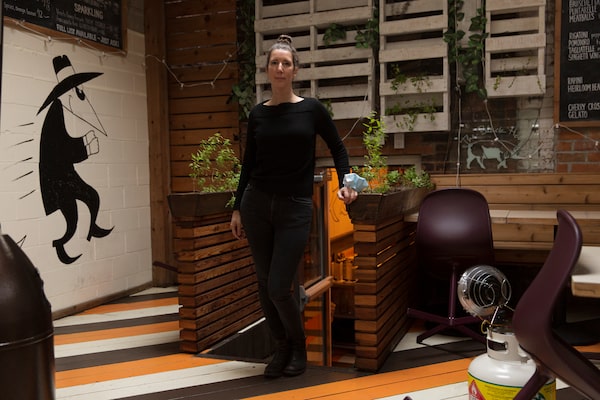

Before the November lockdown began, Ms. Agg and her husband would have a meal together on Bar Vendetta's patio under an electric blanket. She says it felt like the last time they'd see other people for a while. At bottom, Bar Vendetta's Annalisa Lattavo and chef Peter Nguyen prepare and pack meals.Photos: Jenna Marie Wakani/The Globe and Mail
There is nothing quite like the obvious lack of bustle in a dining room that has not properly served its purpose in nine months. There are restaurants all around Toronto (indeed, in cities around the world) that now exist as microcosmic ghost towns. The hole left behind as COVID-19 tore through these spaces, and our psychology, is hard to articulate, especially as we are still inside it. Everything is hard to see clearly when you’re still inside. The nebulous unknown everyone is living through, yet so specific to the restaurant industry, is not water I’m used to swimming in. The isolation, the economic insecurity, the feeling that we are living through a science-fiction novel – it’s all incredibly destabilizing. As the leader of a company, my role is clearly defined: I conceptualize, design and build spaces, and then try to steer them in the right direction with a lot of help from partners, managers and staff. But it can also be distilled down to one thing: decision-making. Every single thing I’ve done for the past 12 years, since opening my first restaurant, has been a decision, a choice. Have I always made the right one? Hell, no! But that’s part of the fun.
These days, I have fewer decisions to make, and none of them fun. Feeling like I have absolutely no control over what is going to happen to my restaurants, or in my husband’s recovery, has been a gut punch, a complete demolition of everything I use to hold up the foundation of my mental well-being.
But then I’m reminded of why I do this.
Late one afternoon, a few days before the Nov. 23 lockdown, which banned outdoor dining in Toronto, Roland and I went to Vendetta for what felt like the last time we’d see other people. Sitting on the patio, wrapped in an electric blanket, we were the only people there for most of our 4 p.m. meal.
We had two pomodoro pastas, each with one meatball, some rapini and most of a bottle of burgundy. It was one of the best meals I’ve ever had, not because of anything particular to the food or company – both were lovely as usual – but because I knew I would have to hold on to that memory for a long time. That it would have to carry me all the way to whenever this is over and, really, who knows when that will be.
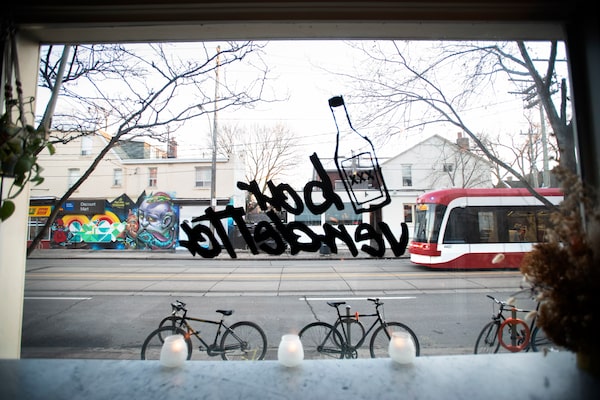
Fred Lum/The Globe and Mail
Keep your Opinions sharp and informed. Get the Opinion newsletter. Sign up today.